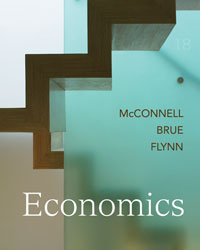Economics (McConnell), 18th EditionChapter 16:
Public Goods, Externalities, and Information AsymmetriesWorked Problems <a onClick="window.open('/olcweb/cgi/pluginpop.cgi?it=jpg::::/sites/dl/free/0025694212/384254/wp_icon_20.jpg','popWin', 'width=NaN,height=NaN,resizable,scrollbars');" href="#"><img valign="absmiddle" height="16" width="16" border="0" src="/olcweb/styles/shared/linkicons/image.gif"> (19.0K)</a>
Problem 16.1 - Optimal amount of a public good <a onClick="window.open('/olcweb/cgi/pluginpop.cgi?it=jpg::::/sites/dl/free/0025694212/384254/wp_icon_20.jpg','popWin', 'width=NaN,height=NaN,resizable,scrollbars');" href="#"><img valign="absmiddle" height="16" width="16" border="0" src="/olcweb/styles/shared/linkicons/image.gif"> (19.0K)</a>
Problem 16.1 - Optimal amount of a public good
Problem: Three individuals' demand schedules for a good are shown in the table below. Assume these are the only individuals in the society. Lynn | | Mark | | Pete | P | Qd | | P | Qd | | P | Qd | $14 | 1 | | $14 | 0 | | $14 | 0 | 13 | 2 | | 13 | 0 | | 13 | 1 | 12 | 3 | | 12 | 0 | | 12 | 2 | 11 | 4 | | 11 | 1 | | 11 | 3 | 10 | 5 | | 10 | 2 | | 10 | 4 | 9 | 6 | | 9 | 3 | | 9 | 5 | 8 | 7 | | 8 | 4 | | 8 | 6 | 7 | 8 | | 7 | 5 | | 7 | 7 |
- If this is a private good, what is the total quantity demanded at a price of $13? What is the total quantity demanded at a price of $11?
- Assuming this is a private good whose marginal cost is constant and equal to $10, determine the optimal quantity of the good.
- Now assume this is a public good. What is the marginal benefit of the second unit of this good? What is the marginal benefit of the third unit? The fourth unit?
- If the marginal cost is constant and equal to $30, determine the optimal quantity of this public good.
| Answer: - For a private good, the total quantity demanded is the sum of the quantities demanded by each of the three individuals at a given price. At a price of $13, the total quantity demanded is 3: 2 from Lynn, 0 from Mark, and 1 from Pete. At a price of $11, the total quantity demanded is 4 + 1 + 3 = 8.
- The optimal amount occurs where price and marginal cost are equal. Since marginal cost is $10, price must be $10. At this price, the total quantity demanded is 5 + 2 + 4 = 11 units.
- The marginal benefit of any particular unit is the sum of the values placed on that unit by each of the individuals. In this example, the marginal benefit of the second unit is $35: $13 by Lynn, $10 by Mark, and $12 by Pete. The marginal benefit of the third unit is $12 + $9 + $11 = $32. The marginal benefit of the fourth unit is $11 + $8 + $10 = $29.
- Comparing marginal benefit to marginal cost, the third unit should be provided, as its marginal benefit of $32 exceeds its marginal cost of $30. However, the fourth unit should not be provided as its marginal benefit is less than its marginal cost: $29 < $30.
|
 | 




